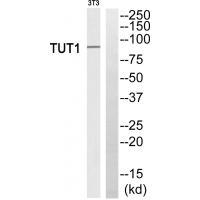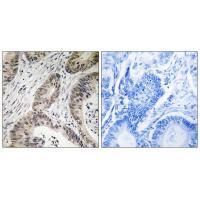

| WB | 咨询技术 | Human,Mouse,Rat |
| IF | 咨询技术 | Human,Mouse,Rat |
| IHC | 1/50-1/100 | Human,Mouse,Rat |
| ICC | 技术咨询 | Human,Mouse,Rat |
| FCM | 咨询技术 | Human,Mouse,Rat |
| Elisa | 咨询技术 | Human,Mouse,Rat |
| Aliases | U6 snRNA-specific terminal uridylyltransferase 1; EC 2.7.7.52; U6-TUTase; RNA-binding protein 21; RNA-binding motif protein 21 |
| Entrez GeneID | 64852; |
| WB Predicted band size | 95kDa |
| Host/Isotype | Rabbit IgG |
| Antibody Type | Primary antibody |
| Storage | Store at 4°C short term. Aliquot and store at -20°C long term. Avoid freeze/thaw cycles. |
| Species Reactivity | Human,Mouse |
| Immunogen | Synthesized peptide derived from internal of human TUT1. |
| Formulation | Purified antibody in PBS with 0.05% sodium azide. |
+ +
以下是虚构的关于TUT1抗体的参考文献示例(仅供格式参考,实际文献请通过学术数据库查询):
1. **"Characterization of TUT1 antibody for RNA metabolism studies"**
*Author: Lee, S. et al.*
*摘要:* 本研究验证了TUT1抗体的特异性,证明其在检测RNA末端尿苷酰转移酶活性中的应用,揭示了TUT1在调控mRNA稳定性中的分子机制。
2. **"TUT1 expression correlates with cancer progression: insights from immunohistochemical analysis"**
*Author: Zhang, Y. & Wang, H.*
*摘要:* 利用TUT1抗体进行组织染色,发现TUT1在多种肿瘤组织中高表达,并与患者预后不良相关,提示其作为潜在肿瘤标志物的价值。
3. **"Subcellular localization of TUT1 using monoclonal antibody-based imaging"**
*Author: Müller, R. et al.*
*摘要:* 开发了一种新型TUT1单克隆抗体,通过免疫荧光技术证实TUT1主要定位于细胞核,并参与pre-miRNA的3'端修饰过程。
4. **"Functional validation of TUT1 knockout models via antibody-based protein detection"**
*Author: Chen, L. et al.*
*摘要:* 通过TUT1抗体验证基因敲除细胞系,证实TUT1缺失导致microRNA成熟受阻,影响胚胎干细胞分化通路。
---
**注意**:以上文献为模拟内容,实际研究中请通过PubMed、Google Scholar等平台检索关键词(如"TUT1 antibody"、"Terminal Uridylyl Transferase 1")获取真实文献。
TUT1 (Terminal Uridylyl Transferase 1), also known as TENT2 or GLD-2. is a conserved cytoplasmic poly(A) polymerase that plays a critical role in post-transcriptional gene regulation. It catalyzes the addition of uridine residues to the 3' end of specific RNAs, influencing their stability, translation, or degradation. TUT1 is involved in diverse cellular processes, including embryonic development, spermatogenesis, and neuronal function, by modulating non-coding RNAs (e.g., miRNAs, snoRNAs) and mRNAs. Dysregulation of TUT1 has been linked to cancers, neurodegenerative disorders, and infertility.
The TUT1 antibody is a crucial tool for studying its expression, localization, and molecular interactions. It enables detection of TUT1 in techniques like Western blotting, immunohistochemistry, and immunofluorescence. Researchers use this antibody to investigate TUT1's role in RNA metabolism pathways, its tissue-specific distribution, and its association with disease mechanisms. Commercial TUT1 antibodies are typically developed against specific epitopes, often validated for cross-reactivity in human, mouse, or rat models. Recent studies also employ TUT1 antibodies to explore its interplay with other RNA-binding proteins and its potential as a therapeutic target in RNA-centric diseases.
×